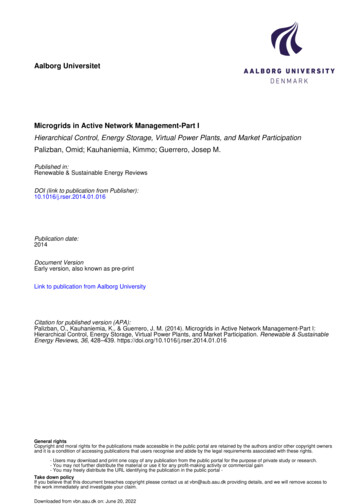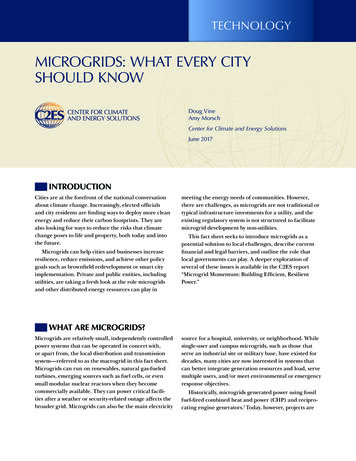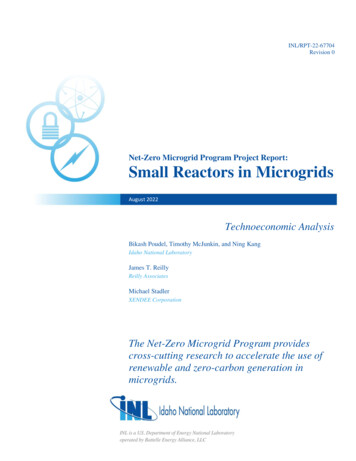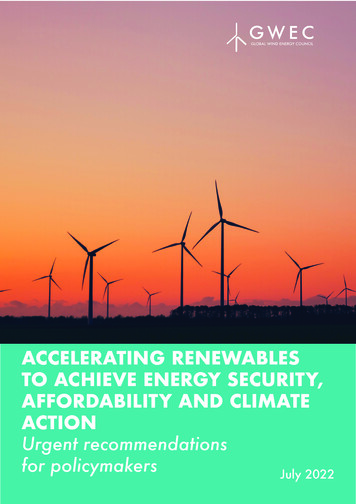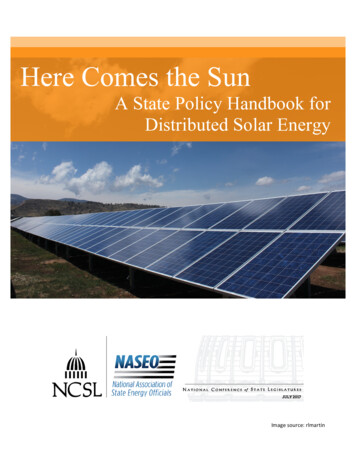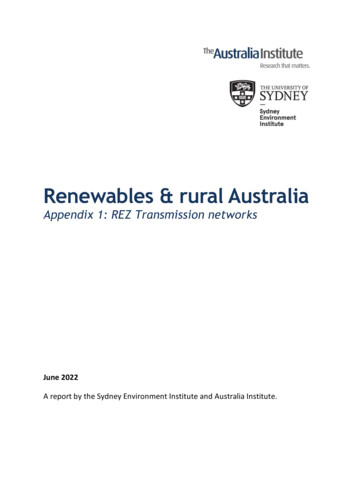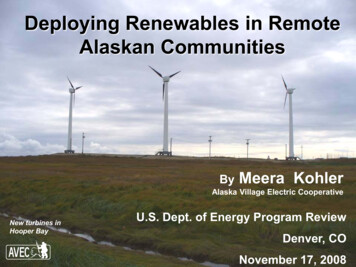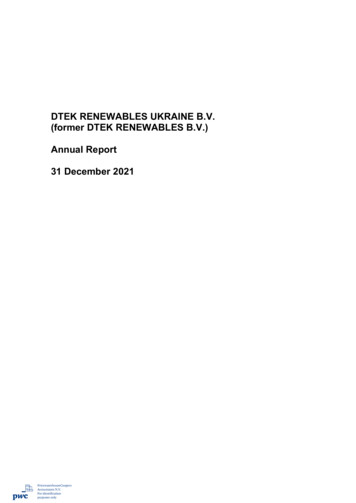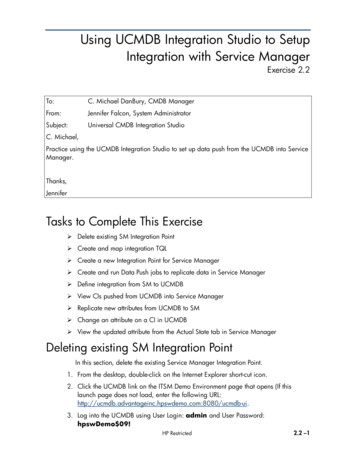
Transcription
Integration of Renewablesand Microgrids in PowerSystems - Present and FutureChallenges and SolutionsQuanta Technology, LLC4020 Westchase BoulevardSuite 300Raleigh, NC 27607 USATel: (919) 334-3000www.quanta-technology.comSource: content.caiso.com/green/renewrpt/20141019 DailyRenewablesWatch.pdfCopyright 2014 Quanta Technology, LLCConfidential & ProprietaryOctober 20, 2014
Agenda1. Introduction and ObjectivesJulio Romero Aguero (Quanta Technology)2. Utility perspective on MicrogridsShay Bharamirad (ComEd)3. Advanced Modeling and Analysis to Support HighPenetration of Distributed Solar PVRobert Sherick (Southern California Edison)4. ISO perspective on Renewable IntegrationPengwei Wu (ERCOT)5. DER and Microgrids - A Sure thing or a Fading Myth?Johan Enslin (University of North Carolina at Charlotte)Copyright 2014 Quanta Technology, LLC2
Introduction and Objectives Objectives:– Review of industry practices for integration of renewablesand microgrids in T&D grids– Discussion of emergent trends, challenges and solutionsCopyright 2014 Quanta Technology, LLC3
Introduction and Objectives Why is this important?Source: content.caiso.com/green/renewrpt/20141019 DailyRenewablesWatch.pdfCopyright 2014 Quanta Technology, LLC4
Introduction and Objectives Are we heading in this ity-produced-in-germany.htmlCopyright 2014 Quanta Technology, LLC5
Shay BahramiradShay Bahramirad is a Manager of Smart Grid and Technology atComEd. Her responsibilities include leading the Smart Grid organizationacross ComEd, business case development and performance measuresfor Smart Grid technology deployments, and defining, developing, andimplementing Smart Grid initiatives in ComEd’s service territory. She isalso an Adjunct Professor at the Illinois Institute of Technology. Shayholds multiple advanced degrees, including a Ph.D. in ElectricalEngineering from the Illinois Institute of Technology. She is a U.S.representative of power quality monitoring in CIGRE and leads thedevelopment of the IEEE P1815 Standard: Smart Distribution ApplicationGuide, and serves as Technical Chair of several IEEE conferences suchas T&D and the Great Lake Symposium. She is the recipient of the 2014IEEE PES Outstanding Young Engineer Award.Presentation: Utility Perspective on MicrogridsCopyright 2014 Quanta Technology, LLC6
Robert SherickRobert Sherick is a Principal Manager in SCE’s AdvancedTechnology Group. Robert manages a group of engineers working onrenewable integration analysis, real-time digital simulations of the powersystem, and situational awareness technologies. His prior experienceincludes working as the Director of Power Supply for Pasadena Waterand Power, Product Manager for Sungard Energy Systems, a Manager atDeloitte Consulting, and various engineering and operational roles at theLos Angeles Department of Water and Power. Robert has a Masters inBusiness Administration from the Claremont Graduate School and aMasters in Electrical Engineering from the University of SouthernCalifornia.Presentation: Advanced Modeling and Analysis to Support HighPenetration of Distributed Solar PVCopyright 2014 Quanta Technology, LLC7
Yunzhi ChengYunzhi Cheng is Senior Planning Engineer at ERCOT (ElectricalReliability Council of Texas). He received his B.S. and M. S. degreesfrom Shanghai Jiaotong University, Shanghai, China, and Ph.D. degreefrom the University of Texas at Arlington, Arlington, TX, USA, all inelectrical engineering. During 2003 to 2006, he worked as aTransmission & Generation Planning Engineer at East China ElectricPower Design Institute, focusing on power system planning for EastChina Power Grid. From 2009 to 2014, Dr. Cheng worked as a Managerof Power System Studies at PwrSolutions, a DNV GL company at DallasTexas. His areas of interest include renewable energy modeling andintegration, power system stability, dynamic parameter identification,state estimation, blackout restoration, hydrogen economy, and powermarket.Presentation: ISO Perspective on Renewable IntegrationCopyright 2014 Quanta Technology, LLC8
Johan EnslinJohan H Enslin PhD, is the Director for the Energy Production andInfrastructure Center (EPIC) and the Duke Energy DistinguishedChaired Professor in Power System at UNC Charlotte. Enslin hascombined a 33-year career with leadership in industry and academia; inthe US, Europe and South Africa. He served as an executive for privatebusiness operations and a professor in electrical engineering. Dr. Enslininitiated and led renewable energy teams, companies and executedmulti-disciplinary power system projects. Johan worked for more than 80US, European, Asian and African power utilities, governments andindustries. He authored more than 280 journal and conference papers forIEEE and other organizations, and has written several chapters inscientific books. Johan is a leader in IEEE and CIGRÉ. He holds morethan 21 provisional and final patents. He is a registered ProfessionalEngineer, IEEE and SAIEE Fellow.Presentation: DER and Microgrids - A Sure thing or a Fading Myth?Copyright 2014 Quanta Technology, LLC9
Utility perspective on MicrogridsShay Bahramirad, PhDManager of Smart Grid & TechnologyOctober 2014
COMED OVERVIEW The service territory covers 11,400 mi2 in Northern Illinois Serving about 3.8 million (70%) of the customers in Illinois ComEd delivers electricity to 400 municipalities, includingthe City of Chicago 23,750 MW all-time system peak (summer 2011) Transmission lines at 138, 345, 765 kV About 5,700 miles of transmission (69 -765kV) lines andabout 66,000 miles of primary distribution (4 - 34kV) lines 225 HV, 526 MV distribution substations 5400 Distribution Feeders at 4, 12.5, 34.5 kV11
ELECTRIC UTILITIES ARE FACING SIGNIFICANT CHANGES Stressed and Aging Infrastructureo Climate change resulting in increased weather volatility Demand for grid hardening and off-grid solutionso Grid security and resiliency Concerns are driving operating expenses and capital expenditureo Constrained delivery of gas and power Creates a need for transmission and gas storageo Increasing utilization of natural gas Driven by low supply costs, new infrastructure, and the desire for clean and resilient energy Improving CHP and Fuel Cell technologies enable gas to replace network-delivered electricity Shifting Customer Expectations & Segmentationo Increasing customer expectations and segmentation Cleaner, more affordable, more reliable, and secure energy Lower tolerance for outageso Internet of Options Increase in big data driving an increase in customer options To meet these challenges new technologies will have to implemented,such as microgrids12
SIMPLIFIED MICROGRIDUtility gridSubstationLoadDGMicrogrid is an integrated power delivery systemconsisting of interconnected loads andDERs that can operate in:Cluster DG and Load grid-connected mode, stand-alone (islanded) mode, ride-through between the above modes. Operates within clearly defined boundaries Appears as a single controllable entity wrt. to the gridDefinition: DOEMicrogrid ExchangeGroup13
MICROGRIDS Why a microgrid?o Improved capacity, resiliency, reliability, efficiency and power quality Storms and terrorismo Improved physical and cyber securityo Increased sustainabilityo Smaller environmental impact Cleaner DG (distributed generation)Sniper attack on PG&E’s Metcalf substation14
MICROGRID CONTROLLER U.S. Department of Energy announced 8 Million in grant funding to improve gridresiliency DOE awarded approximately 1.2 million to ComEd and it’s partners to develop andtest a commercial-grade microgrid controller capable of managing two or moreinterconnected microgrids ComEd’s project includes a diverse mix of facilities and critical loads, including policeand fire department headquarters, major transportation infrastructure, healthcarefacilities for seniors, and private residences15
COMMUNITY MICROGRIDEvaluation of a potential project could cluster two microgrids in a communityComEd is evaluating Chicago’s Bronzeville neighborhood for implementation of apotential microgrid The potential location is adjacentto Illinois Institute of Technology(IIT) which has a microgrid Would create the first clusteredmicrogrid in the world. Location is a great cross section ofthe City of Chicago, with a diverseset of critical loads– High tech manufacturing– Educational facilities– Police headquarters– Healthcare and senior residences– Other private residences-16-
COMMUNITY MICROGRID Feeders would be reconfigured ina loop scheme which ties to theIIT microgridPOI3POI1B1B4B2GSB3 Mix of generation sources wouldbe required – could include fuelcells, solar, natural gasgenerator(s), storage, etc. It would provide a decentralizeddistribution model that does notdepend on the rest of the ComEdsystem availabilityPotential ComEd MicrogridIIT MicrogridBCCCB6B5DLIPD4.16/12.5 kVFC2 2MWTiePOI2RCRoof-top PVMAAutomated switchesGLVista SwitchFCFuel cell5 MWPOI4-17-COBES
MICROGRID REGULATORY ISSUES In Illinois utilities and power generation are separated – utilities do nottypically own generation assets. Generation assets are allowed for back-up purposes onlyo Utilities are to provide strictly power distribution and transmission services Options to study microgrids with generations assets for pilot purposes:o Classify microgrid, including distributed generation assets, as R&D asseto Operating lease of generation assets from third partyo Third party ownership of generation Microgrids are emerging technology:o Lack of regulatory framework specifically devoted to microgrids-18-
MICROGRID – FUTURE APPLICATIONS Future microgrid deployments would focus on locations with criticalinfrastructure, such as hospitals and airports Clustering multiple microgrids together would improve the resiliency andpower quality delivered to the loads Other potential applications could be business districts, universities and parkdistricts Premium service – customer willing to pay more for improvedreliability/resiliency-19-
MICROGRID – FUTURE APPLICATIONSAC/DC Hybrid Microgrids Future application that combines AC and DCpower systemsoAC bus Natural gas, wind turbines etc. Conventional AC loadsoDC bus Solar, fuel cells, batteries etc. DC loads (data centers, variablefrequency drives)oCoupled through a three-phaseconverter that operates as either aninverter or a rectifier Can operate in grid connected or islandedorientation ComEd is currently evaluating areas withinwhich this technology could be deployed in-20-
MICROGRID FUTURE Microgrids are becoming a high profile and highly visible market North American microgrid capacity is projected to reach almost 6GW by 2020o Six times the existing microgrid capacity Annual investments in building microgrids worldwide are expected to quadruplefrom 10B to 40B by 2020o 50% of microgrids being formed in North America Utilities should be prepared for a range of roles in developing, installing, andoperating microgridso Depends on the customer situation and ability to own DG resources Spectrum of utility ownership:o Ability to sell generation into the market and use of DG for economic dispatch Microgrid investments:o Transmission and distribution upgrades as well as the microgrid controllers typicallyaccount for less than 40% of the microgrid’s cost.o DG accounts for rest of the costs, but varies based on technology.-21-
IN SUMMARY Microgrids are becoming more popular because the reliability and resiliencyimprovements they can provide ComEd is working on several microgrid related projects:o Microgrid controller developmento Evaluating areas for public good microgridso Evaluating potential locations for microgrid clusters and AC/DC hybrid microgrids Microgrid challengeso Lack of regulatory standardso Interconnection procedureso Standby rates and tariff treatmentso Valuation of benefits, especially for value of reliability and resiliencyo Customer education and expectations-22-
Southern California EdisonAdvanced Modeling and Analysis to Support HighPenetration of Distributed Solar PVOctober 21, 2014Robert Sherick
Southern California Edison SCE Service Area– 50,000 square miles– Over 400 cities andcommunities– 13.5 million residentsPG&E– 4.9 million customer accounts SCELADWPSDG&EElectric Revenues of 10 billion
Solar PVDistribution Interconnected Solar PV (6/14)1000Nameplate Capacity (MW)900800700Non-NEM CulmulativeTotal (MW)600500400NEM Culmulative Total(MW)30020010001998 1999 2000 2001 2002 2003 2004 2005 2006 2007 2008 2009 2010 2011 2012 2013 2014Time26
Demonstration and StudiesIrvine SmartGridDemonstrationTehachapiStorageProjectHigh Penetration PVIntegrationDistributionPlanning &AnalysisDistributedVolt/VAR ControlScreeningDistribution Feeders27
Advanced Distribution AnalyticsFrom advanced modeling andanalysis to streamlined interconnection28
Project Objectives Understand distribution feeder native capability Develop a common framework to extend capability––––Improve mitigation plansIncrease transparency of mitigation strategiesImprove siting decisionsImprove cost estimates Increase overall PV adoption rate– Streamline the process and improve the quality of interconnectionapplications– Enhance collaboration with stakeholders through on-line systems Evolve the planning process– People, process, and technology29
Different Type of Analysis Level of Detail Behind-the-Meter Forecasting Adoption Behavioral Understanding Holistic Analysis Interactions Coordination Optimization ofInterconnectedness Locational Value Temporal Considerations30
What we conomicAnalysisInternet of things provides the beginnings of an opportunity Interconnected devices that interoperate Enabling innovation
What we don’t know (not a comprehensive list) Planning for safe/reliable/affordable with uncertainty– Lifecycle of assets– Forecasting technology adoption Interconnection Protocols to Enable Value– What are the dynamics of interconnected devices?– Are there real benefits and at what cost?– What framework creates device synergies? What Value for How Long?– Mark-to-Market technology Flexibility of the System through Design– Value of flexibility – real options Capturing the value without dictating a technology32
QuestionsRobert Sherickrobert.sherick@sce.com714 934-081333
ISO Perspective on RenewableIntegrationPrepared by Pengwei DuPengwei.Du@ercot.comPresented by Yunzhi ChengYunzhi.Cheng@ercot.com
Table of Contents– Load and Wind resources in ERCOT– Short-term Wind Potential Forecast and ERCOT Large Ramp AlertSystem– Solar Integration– Summary Acronyms for this presentation:––––––WGR: Wind-powered Generation ResourceAS: Ancillary ServiceSTWPF: Short-term Wind Power ForecastCOP: Current Operating PlanRUC: Reliability Unit CommitmentELRAS: ERCOT Large Ramp Alert System35
ERCOT MAP36
Annual Energy & Peak Demand (2003-2012)37
Installed Wind Generation in ERCOT38
Wind Resource39
Projected Installed Capacity of PV in ERCOTProjected Intalled Capacity of PV 325020142015402016
Correlation between Wind and 345678910 11 12 13 14 15 16 17 18 19 20 21 22 23 24Hour41System Total Wind (MW)System Total Load (MW)60000
Importance of Wind Forecast“the seamless integration of wind plant output forecasting – into bothpower market operations and utility control room operations – is acritical next step in accommodating large penetrations of wind energy inpower systems” DOE, 20% Wind Energy by 2030 (Washington, DC: DOE, 2008),http://www.20percentwind.org/20p.aspx?page Report.42
Forecast vs. Observed Time Series – November 2012 (LowMAE month despite high wind variability)43
ERCOT Large Ramp Alert System (ELRAS) The main focus of ELRAS is to provide the probabilities of WindPower ramp events of various MW changes over various time frames– The far right graph shows that there is a 30% chance of the wind outputchanging by 2000 MW or more between 18:00 and 21:00– Information is provided for both the system and region levelsUP44
Power Produced from Two PVGRsERCOT & QSE Summary6/6/2014 11:59:59 PM\\EDS PI\ACACIA.UN.UNIT 1.ANLG.MW0.0000MW\\EDS PI\OCI ALM1.UN.UNIT1.ANLG.MW0.0000MW\\EDS PI\ERCOT.LOAD40583MW10 40 :00ACACIA.UN.UNIT 1.ANLG.MW OCI ALM1.UN.UNIT1.ANLG.MW9:0010:00ERCOT 023:00
Integrated Framework in OperationResourcesDispatch Merit OrderGeneration RampingCharacteristicsRegulation reservesWhat we are atWhat supply has beendispatchedWhat is the actualgeneration outputTrend of frequency/ACEWhat is going tochangeLoad forecastWind/Solar forecastAvailability and outageLarge-ramp forecastOperators see impactof dispatch over thefuture operationsIntegratedOperational ToolUncertainty analysisRisk assessment andtrigger further analysis46Alarm for unforeseen windramp events, large forecasterrors, extreme penetrationlevel of wind generation
Summary As the Operators enter the Operating Day, they are able to executehourly RUC studies– The Operators would like to wait as close to real-time as possible to commit aResource The Operator is also able to begin using the ERCOT Large Ramp AlertSystem (ELRAS)– ELRAS provides probabilistic forecast information for the next 6 hours– The displays include animated graphics of weather conditions Probabilistic forecast information will very likely play a key role in GridOperations in the near future– There is still work to be done in the incorporation of the probabilistic forecasts inthe control room47
QuestionsPengwei DuSenior Operation Engineer-Renewable Integration,Ph.D.The Electric Reliability Council of Texas(o) 512-248-6453(c) 510-366-1875Pengwei.du@ercot.com48
DER and Microgrids- A Sure thing or a Fading Myth?Johan H Enslin, PhD, FIEEE, PrEngDirector, Energy Production & Infrastructure Center (EPIC)Duke Energy Distinguished Chaired ProfessorUNC Charlotte, NC, USAJEnslin@uncc.edu; http://epic.uncc.edu
Challenges to (PV) DER Integration- Driven by Incentives? Technology and devices are mostly there – Focus on: BOS systems - racking, permits, installation, etc.Smart inverters - need to be standardized and required in allVirtual Power Plant control and communications.Dispachability of DER systems – Storage, ramping control and DREnergy Analytics – Load, capacity and resource forecasting, DR, etc. What is the business model when FTC and RPS are lifted? Focus on grid parity with dispatched DER Capture multiple revenue streams with different entities into one Market for DER grid support – Volt-VAR; frequency; capacity, spinning reserves, etc. Regulatory challenges – Utility of the future business models? Capacity and reliability markets. Applications Mainly RPS driven with 30% FTC20002 MW PV Plant Production1800Power Production (kW)1600140012002 MW PV Solar generationprofiles during 3 days insouthern California10008006004002000-2006810121416Time (Hour)5-Mar-0919-Mar-0924-Jun-091820
Challenges to Microgrid Integration- What is the business case? Technology and devices are mostly there – Focus on: Area Energy Management Systems (AEMS) and Visualization Micro-Demand Response systems (µDR) Energy Storage dispand Ancillary Services tie-ins What is the business model? Multiple revenue streams with different entities Regulatory challenges – Utility of the future business models? Grid resiliency and energy security funded by Federal AgenciesLegacy gridSynch Switch (CB, PMU & Relay)MicrogridArea Distribution NetworkAEMSMarketsµDRGeneration PlantLoad(Cogeneration, PV)(EV)-CampusesMilitary BasesZero Net Energy Comm.EnergyStorage
Interconnection of DER at DensePopulationsOuddorp, The Netherlands
Technical DER and MicrogridInterconnection Issues Short circuit ratings change over wide range through operation Voltage Regulation and Flicker: May exceeding voltage limits and inverters trip Voltage fluctuations and flicker due to intermittency Harmonics: Inverters individually satisfy PQ standards PQ standards can temporarily be exceeded. Inverters trip unexpectedly Attention Points on Standards and Interconnections Smart inverter settings and closed-loop control Coordinated control of VAR resources and smart inverters Effect of background supply distortion Increased distortion due to a system resonance Microgrids and weak networks Islanding times and algorithms Natural damping
Conclusions & Recommendations DER and Microgrids business case needs to show valuepropositionRegulatory support and policy for DER and MicrogridrolloutFuture Utility Business Models to encourage valuepropositionSmart Inverters, emulating synchronous machinecharacteristics, can mitigate power quality issuesEvaluate and test inverters with real-time HiL TestbedsNeed to develop guidelines and standards for weak,Microgrid, DER or islanded network operations withvariable impedances.
Duke Energy Smart Grid Lab.DESG Control RoomRTDS and OPAL-RTSimulatorsSubstation RelayEquipmentSEL; ABB, etcI/O90 kVA Ametek GridSimulator & AmplifierControlAmetekTerraSAS PVSimulatorDC PowerHP Dedicated Server for DataAnalytics
Duke Energy Smart Grid Lab Real Time Digital Simulator (RTDS) – 3 enhanced racks 32 core OPAL-RT real-time power simulator 90 kVA Ametek Grid Simulator and Amplifier 150 A with 120V, 208V, 480V 1&3 phase power supplies Amatek TerraSAS 10 kW PV SImulator High speed fiber connections between labs and server room Dedicated and secured private LAN for external data streams Raised floor access for power, communication and control cables 6 fast response large LCD Screens and image control Data storage devices and SCADA gateways Communications - Private HP Server for data analytics HP X820, 16-Core, Dual Processor Xeon Workstation Simulation tools including - PSS/E; ETAP; EMTP-RV;RSCAD; PSCAD; Hypersim, RTLAB, etc.
The Emerging Virtual Power PlantSource: Petra Solar, NJ USA
the City of Chicago 23,750 MW all-time system peak (summer 2011) Transmission lines at 138, 345, 765 kV About 5,700 miles of transmission (69 -765kV) lines and about 66,000 miles of primary distribution (4 -34kV) lines 225 HV, 526 MV distribution substations 5400 Distribution Feeders at 4, 12.5, 34.5 kV 1 1
